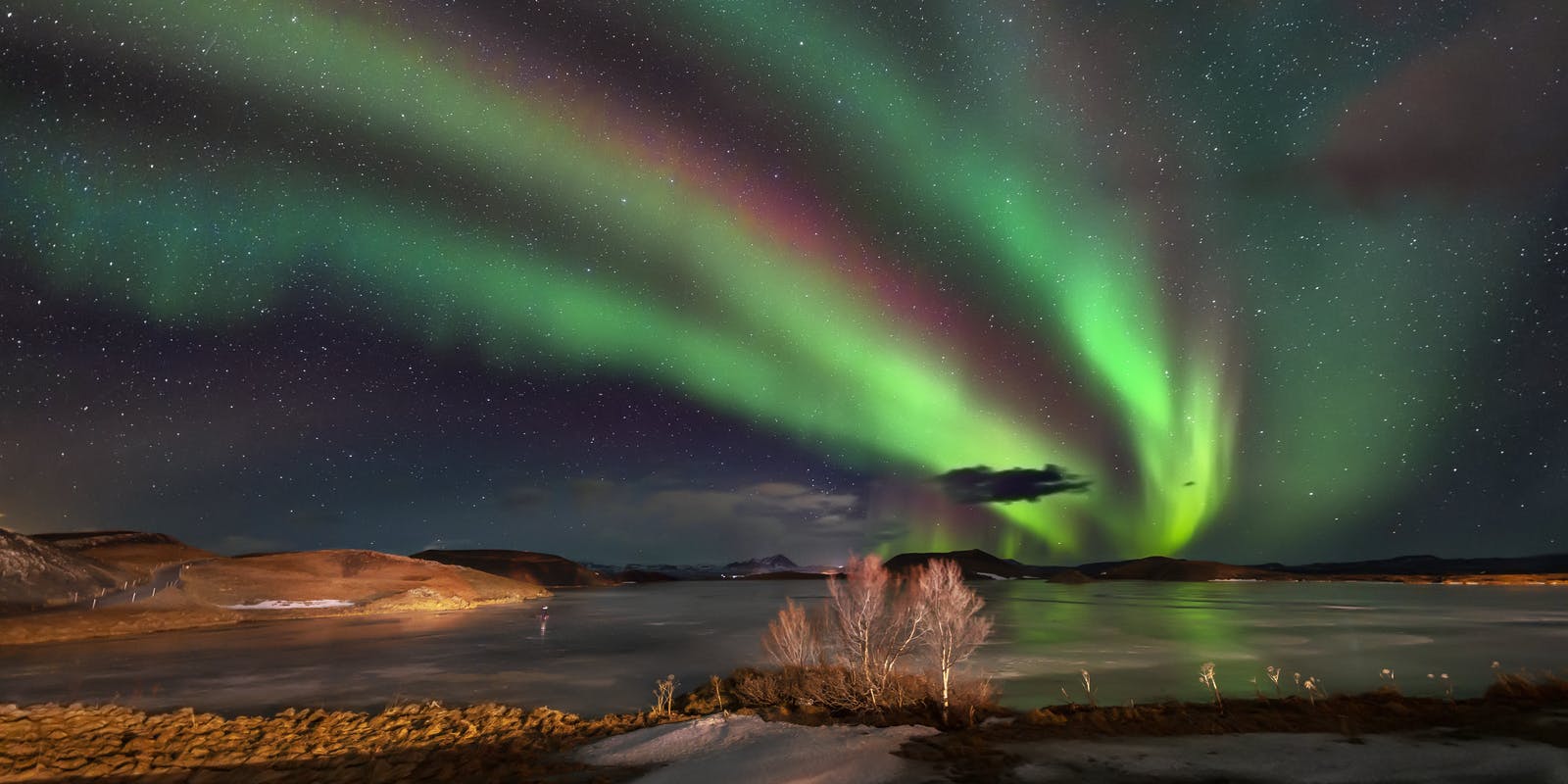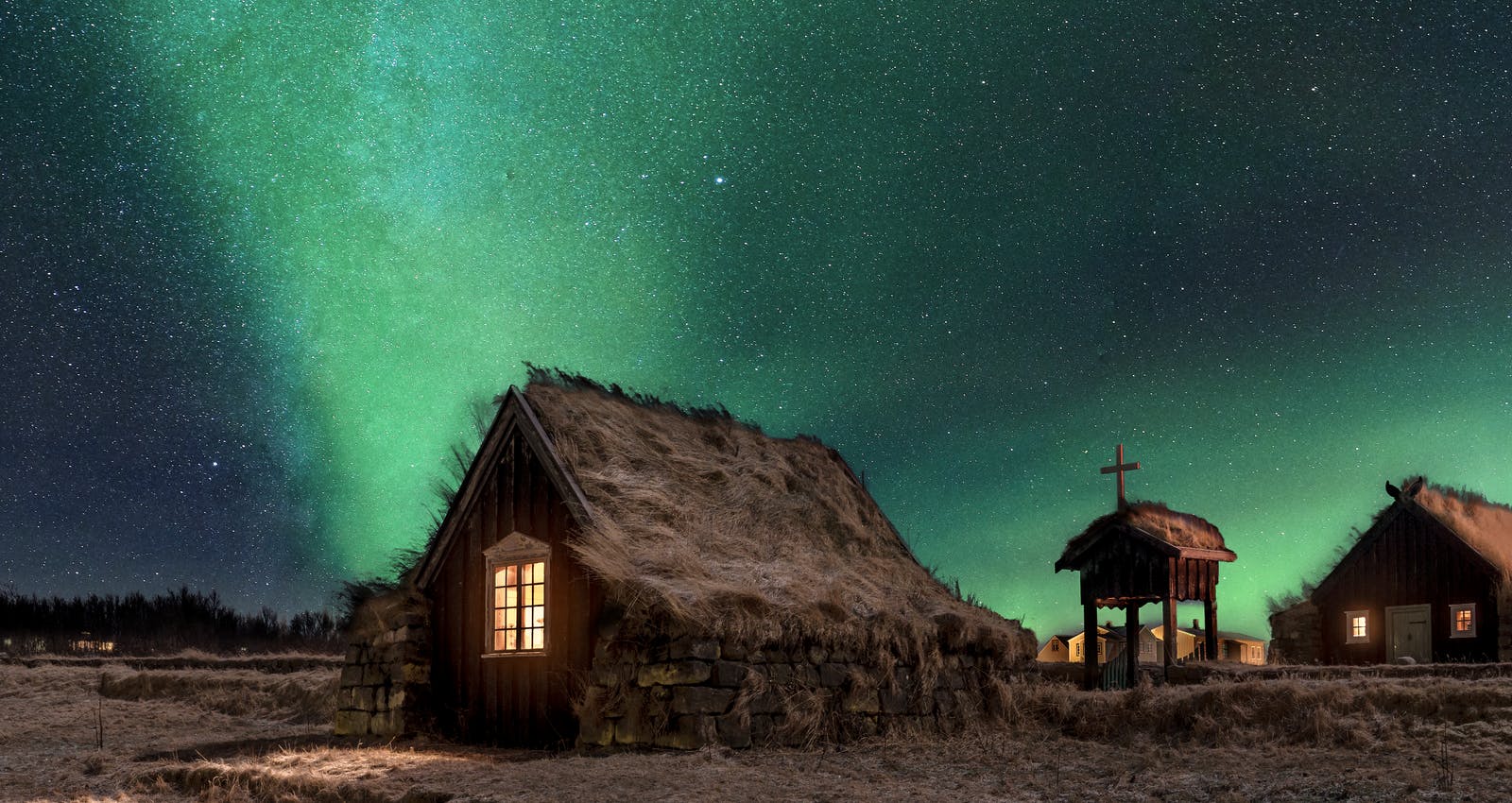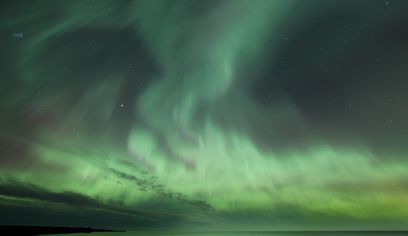
Months of the Northern Lights
Northern lights are a natural phenomenon produced by solar winds, which blow electrically charged into molecules of atmospheric gases, causing bright light emission. While solar activity occurs year-round, there must be dark skies to view auroras, which means the winter months are the time to search for northern lights in Iceland.
When is the Best Time of Year to see the Northern Lights?
One of Iceland’s most popular winter attractions is searching for the otherworldly northern lights (Aurora Borealis). The best time to see the northern lights is from mid-August to late April. We recommend checking an Aurora Forecast to predict visibility. It is even possible to see the northern lights in late August if the conditions are right.

January
Weather Conditions: January is one of the coldest months in Iceland, with temperatures often below freezing. Snow and ice are common, which can make travelling challenging. However, the clear, cold nights can provide excellent conditions for Northern Lights viewing.
Expected Likelihood: High. The long nights and frequent clear skies make January a good month for aurora activity.
Beautiful Locations: The Westfjords, away from city lights, and the northern parts of Iceland, such as Akureyri.
February
Weather Conditions: February is still very cold, with conditions similar to those in January. Snowstorms can occasionally obstruct viewing.
Expected Likelihood: High. The extended darkness continues to favour aurora sightings.
Beautiful Locations: The Snaefellsnes Peninsula and areas around Lake Mývatn.
March
Weather Conditions: As Iceland moves from winter to spring, the days start to get longer. However, long nights still provide ample opportunities for Northern Lights viewing.
Expected Likelihood: High. Though the nights are shortening, they remain dark enough for frequent sightings.
Beautiful Locations: The Golden Circle area, especially Thingvellir National Park, offers great viewing spots.
April
Weather Conditions: April sees gradual warming, though snow can still be present. Cloud cover can be variable, affecting visibility.
Expected Likelihood: High. Even though daylight is increasing, April is one of the best Northern Lights months.
Beautiful Locations: The Eastfjords and the southern coast, including Vik.
May
Weather Conditions: The Midnight Sun begins its ascent, leading to almost continuous daylight in the latter half of the month. This makes viewing the Northern Lights challenging.
Expected Likelihood: Low. Extended daylight significantly reduces opportunities.
Beautiful Locations: The whole of Iceland, but the changes are slim due to daylight.
June
Weather Conditions: June experiences the peak of the Midnight Sun, making it the most challenging month for aurora viewing.
Expected Likelihood: Very low. Sightings are extremely rare.
Beautiful Locations: Realistically, Northern Lights are almost impossible to see in June.
July
Weather Conditions: July continues to experience extended daylight, though not as intensely as June.
Expected Likelihood: Very low. Sightings remain a rarity.
Beautiful Locations: Southernmost regions during the brief moments of twilight, though chances remain slim.
August
Weather Conditions: By mid-August, nights start to darken again, gradually increasing the chances of aurora sightings.
Expected Likelihood: High by the end of the month.
Beautiful Locations: The Westfjords and the central highlands.
See the top things to do in Reykjavík in August.
The Northern Lights are one of Iceland’s biggest attractions, but in August 2026, visitors will witness an even rarer sight. The Solar Eclipse 2026 in Iceland will cast Reykjavík into darkness as the moon completely covers the sun, creating an unforgettable spectacle.
September
Weather Conditions: September sees cooler temperatures and increased rainfall. Cloud cover can be a challenge, but clear nights offer good viewing conditions.
Expected Likelihood: High. The darkening nights and equinox solar activity can lead to vibrant displays
Beautiful Locations: The Reykjanes Peninsula and areas around Reykjavik when skies are clear.
October
Weather Conditions: As days shorten rapidly, the window for Northern Lights viewing expands. Cold, clear nights can offer spectacular displays.
Expected Likelihood: High. The increasing darkness makes for frequent and intense sightings.
Beautiful Locations: The southern coast and the Eastfjords.
November
Weather Conditions: November is cold, and the onset of winter snow is seen. While snowstorms can obstruct viewing, they also create picturesque landscapes when the auroras appear.
Expected Likelihood: High. The long, dark nights are prime for viewing.
Beautiful Locations: The Golden Circle and the northern regions, such as Húsavík.
December
Weather Conditions: December offers the longest nights of the year, maximising the chances of seeing the Northern Lights.
Expected Likelihood: High. Combined with potential solar activity, December can offer some great displays.
Beautiful Locations: Almost anywhere away from city lights, with the Westfjords and the Snaefellsnes Peninsula being particularly good spots.
Best Time of Day to See the Northern Lights
It needs to be dark or deep twilight to see the northern lights; that’s why they can’t be seen during the summer. The sunrise and sunset times in Reykjavík are below; searching for the northern lights should happen after sunset.
Searching for the northern lights should happen after sunset. The sunrise and sunset times in Reykjavík are below:
- January 1: 11:19 am - 3:45 pm
- February 5: 9:55 am – 5:30 pm
- March 5: 8:21 am- 6:59 pm
- April 1: 6:42 am – 8:23 pm
- May 5: 4:39 am – 10:12 pm
- June 5: 3:15 am – 11:39 pm
- June 21: 2:54 am - 12:05 am
- July 1: 3:07 am – 11:55 pm
- August 5: 4:50 am – 10:14 pm
- September 5: 6:16 am – 8:36 pm
- October 1: 7:37 am – 6:57 pm
- November 5: 9:24 am – 4:58 pm
- December 3: 10:51 am – 3:44 pm
- December 21: 11:22 am – 3:30 pm
In the months of April and September, the likeliest time to see the auroras tends to be between 9 pm and 2 am, though they most frequently occur between 11 pm and midnight. Between 4 am and 5 pm, there is typically too much daylight to see the aurora. Exceptions are the darkest months of the year and higher latitudes, such as Svalbard, where it is dark 24/7 from mid-November to the end of January.
Where Can I Learn About Northern Lights All Year Round?
Perlan’s Northern Lights Show, Áróra, is a breathtaking film about northern lights. The film includes many stories, combining science and art to create a unique guest experience. At Perlan, you can learn how northern lights form, hear fascinating tales about them and see fantastic displays. In Icelandic nature and outer space, the northern lights virtually dance around you.
Perlan is home to Iceland’s only planetarium and uses a state-of-the-art 8K projection system and surround sound system to bring you the full spectrum of the magical story of the northern lights.
FAQ
Why is aurora activity stronger close to the equinoxes?
Due to the earth’s axis, as the planet rotates around the sun, the angle of the earth’s magnetic fields changes. During the optimum time, which occurs around the equinoxes, magnetic cracks open up that allow solar particles in, setting off frequent aurora storms, which creates a higher probability of northern light sightings.
How can I increase my chances of seeing northern lights in Iceland?
For a good chance to see northern lights in Iceland, travel during the winter, stay for several nights in Iceland, monitor aurora forecasts, join tours, and most importantly, be patient. Sometimes, you may need to wait for the auroras to appear.
What are the best months to see Northern Lights in Iceland
The northern lights are potentially visible under dark skies from mid-August to late April under a cloudless sky. While they occur year-round, they are weaker than sunlight and therefore, sightings aren’t possible from May to July and most of August.









